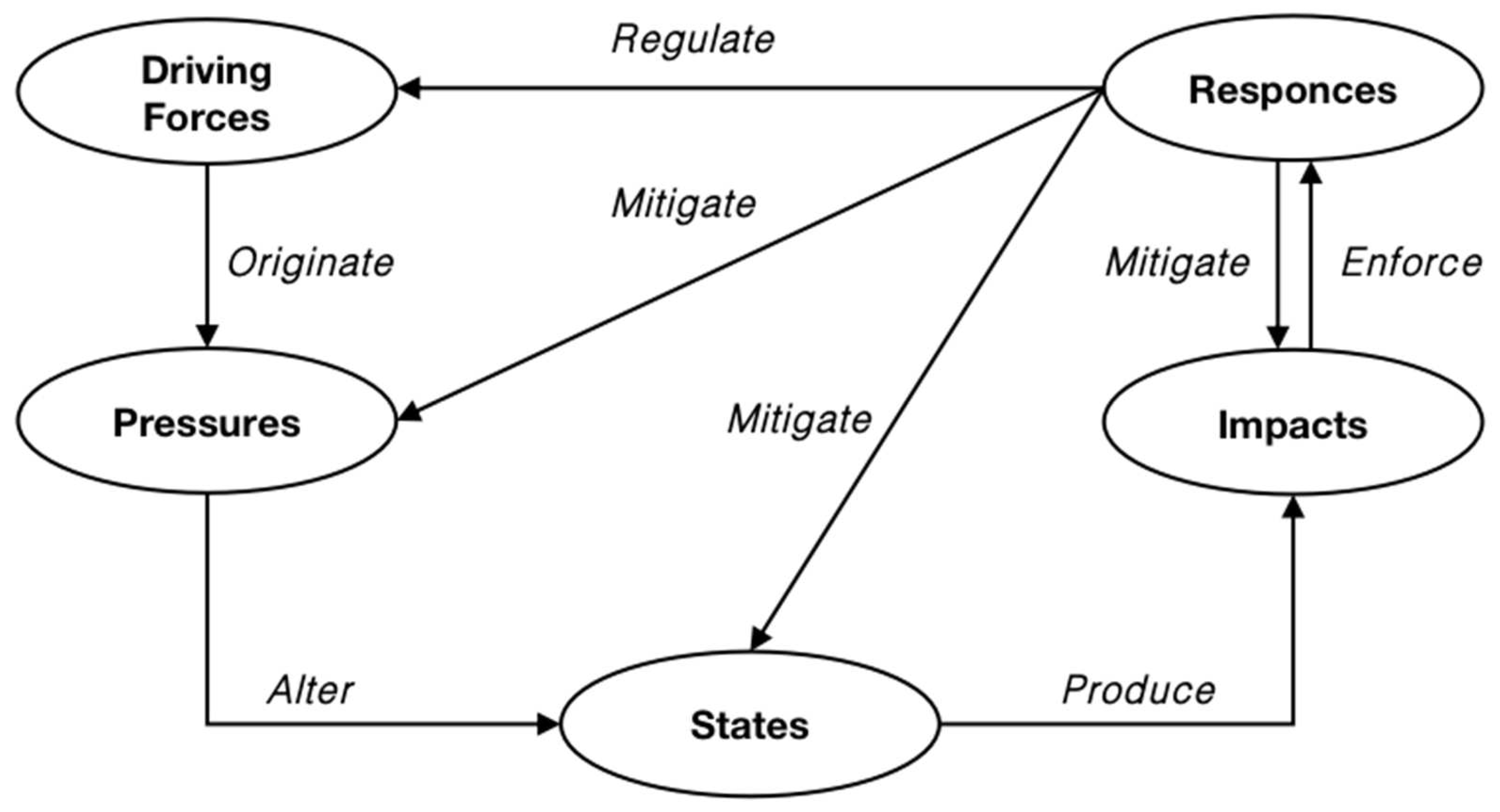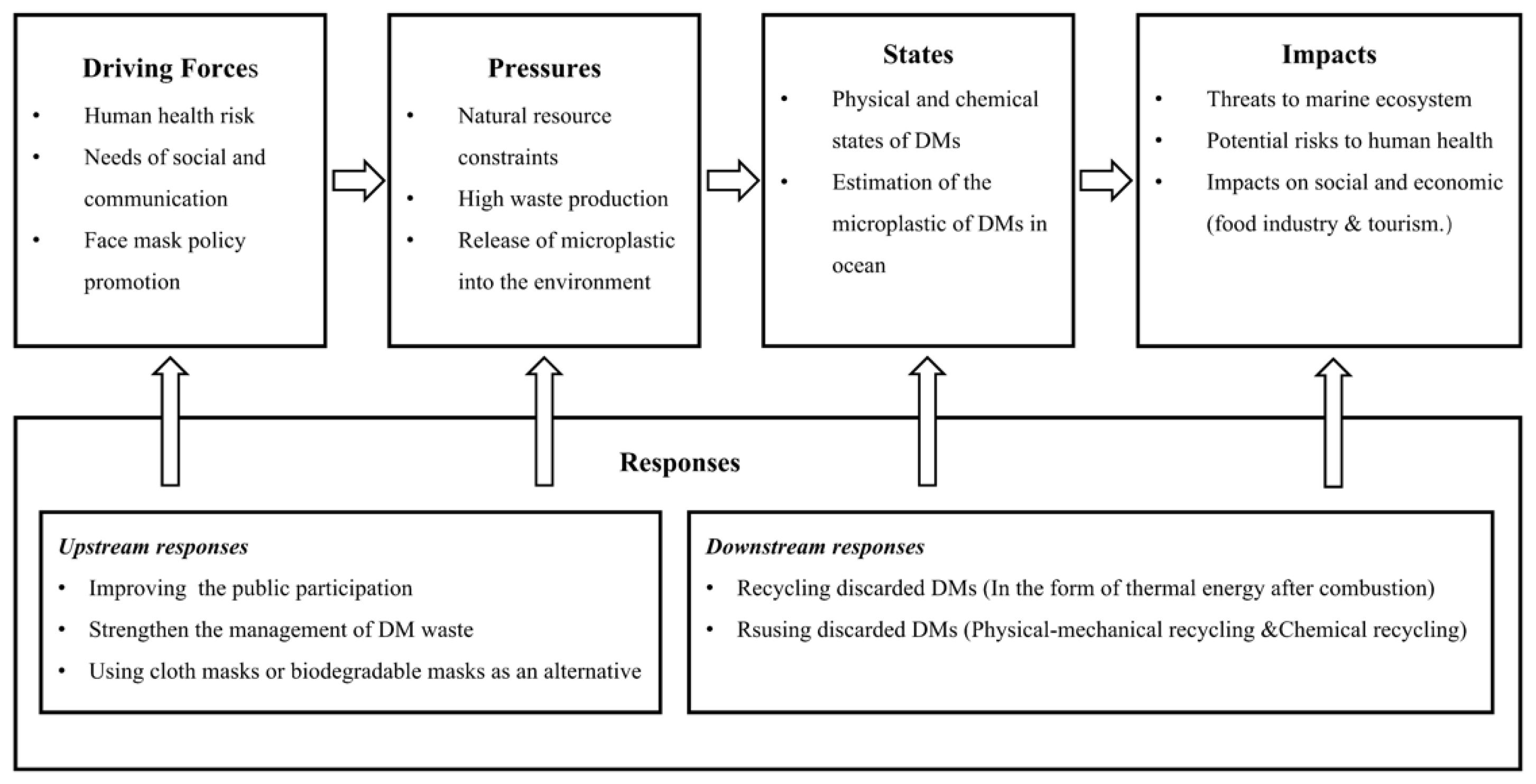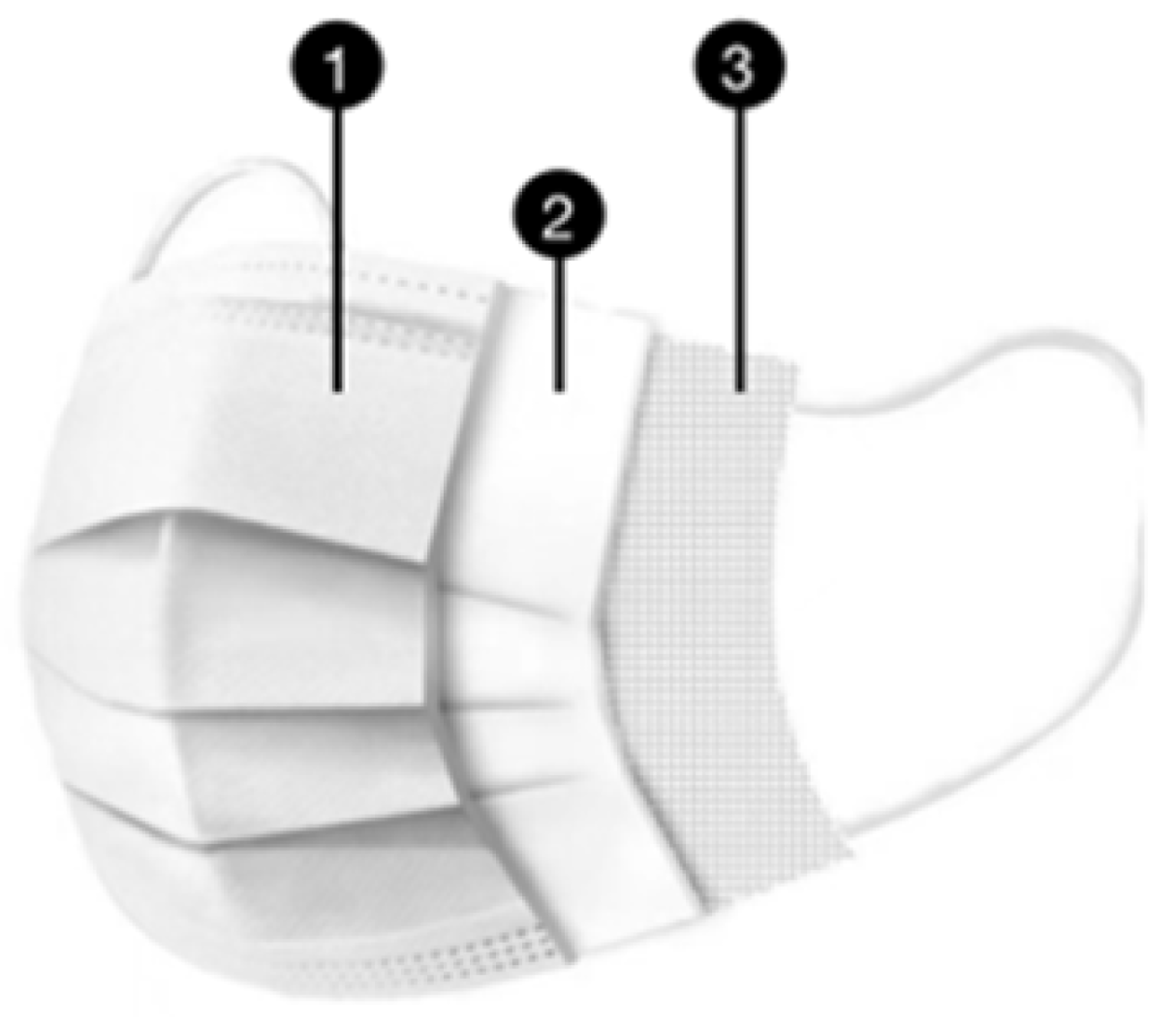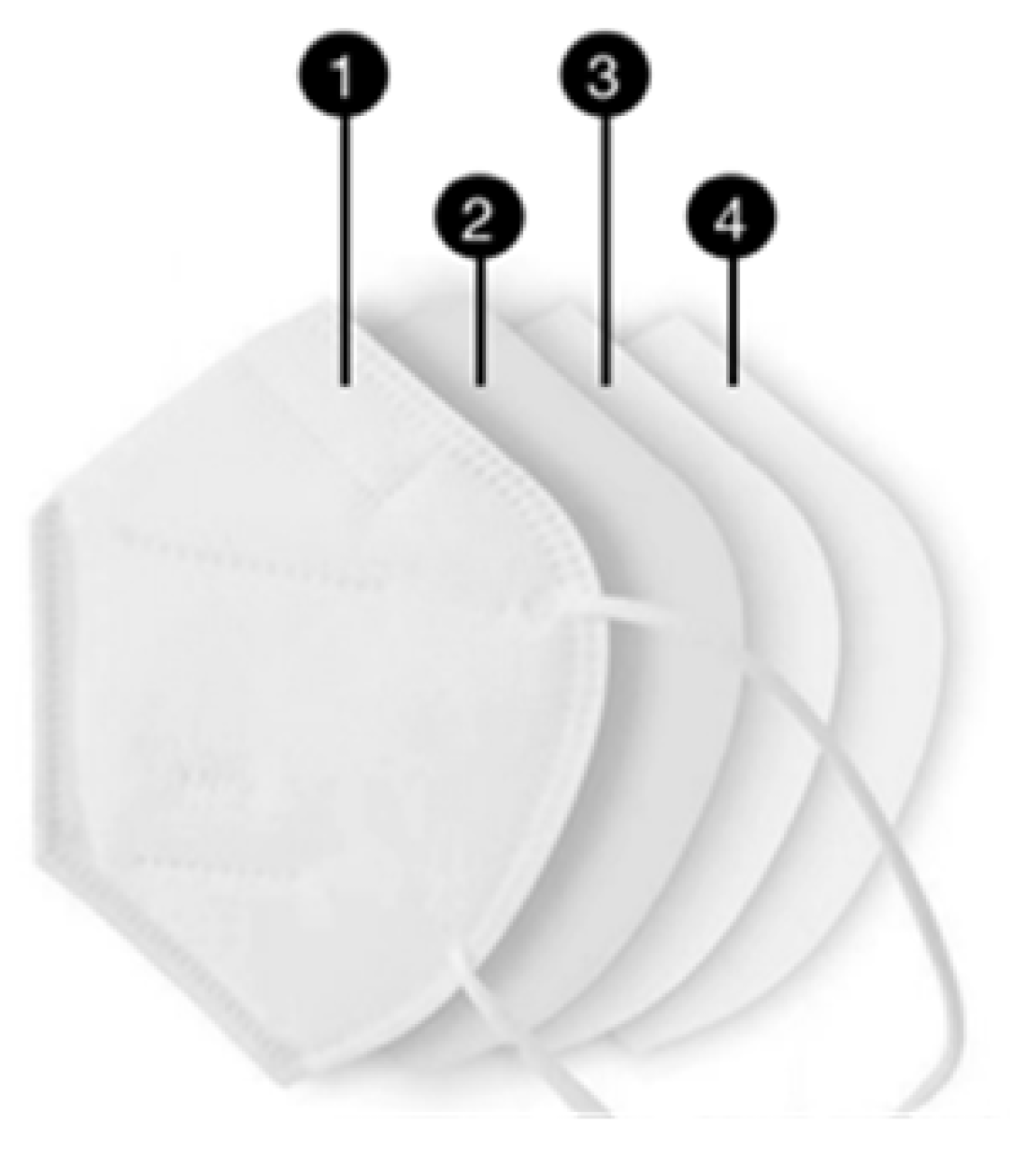Analysis of Marine Microplastic Pollution of Disposable Masks under COVID-19 Epidemic—A DPSIR Framework
Abstract
1. Introduction
2. Methodology
2.1. Concept of DPSIR Framework
- (1)
- The “driving forces” are the most primitive factors that cause environmental change and refer to the social, economic and institutional changes that directly or indirectly trigger environmental stress. It can be defined as “social, demographic, socio-economic development and corresponding changes in lifestyles, as well as overall consumption levels and production patterns” [23]. Rodriguez [24] has divided the level of driving forces into four levels, including “primary driving forces”, “secondary driving forces”, “tertiary driving forces” and “basic driving forces”, which correspond to “socio-economic activities directly related to pressures on the natural environment”, “relevant policies and laws and regulations”, “ideologies and lifestyles” and “trends influenced only by long-term social decisions, such as demographics, culture, etc.”
- (2)
- The “pressures” refer to anthropogenic factors that are directly applied to environmental systems by driving forces and contribute to environmental change, “including emissions of material, physical and biological agents, and the use of resources and space by human activities” [23]. Pressures reflect changes, levels of degradation, and trends in the environment.
- (3)
- The “states” indicate both qualitative and quantitative measurements of pollutants or the current state of the environment or environmental parameters that may change due to pressures [23]. It is worth mentioning that state factors can be explored from the micro level of the physical and chemical state of the pollutant itself [6], or from the macro level of the integrated system composed of pollution sources and environmental composition. Depending on the point of concern, state indicators may vary considerably.
- (4)
- The “impacts” refer to the feedback effects of natural system states on human health, socioeconomics, and ecosystems, which often arise from adverse environmental conditions and are the result of a combination of the first three elements [23]. Impacts reflect changes in ecosystem quality and functions that affect human and social well-being.
- (5)
- The “responses” refer to social actions taken by humans to prevent, mitigate, or eliminate negative impacts [23], which in turn have some impact on the trends of the first four elements.
2.2. Using the DPSIR Framework to Analyze the MMP from DMs
3. Analysis of DMs in MMP Based on the DPSIR Framework
3.1. Driving Forces
3.2. Pressures
3.3. States
3.3.1. Physical and Chemical States
3.3.2. Estimation of the Number of Microplastics of DMs in Ocean
3.4. Impacts
3.4.1. Threats on Marine Ecosystems
3.4.2. Potential Risks on Human Health
3.4.3. Impacts on the Society and Economy
3.5. Responses
3.5.1. Upstream Responses
3.5.2. Downstream Responses
4. Conclusions
Author Contributions
Funding
Institutional Review Board Statement
Informed Consent Statement
Conflicts of Interest
References
- Saadat, S.; Rawtani, D.; Hussain, C.M. Environmental perspective of COVID-19. Sci. Total Environ. 2020, 728, 138870. [Google Scholar] [CrossRef] [PubMed]
- Peeples, L.; Digard, P. Face masks: What the data say. Nature 2020, 586, 186–189. [Google Scholar] [CrossRef] [PubMed]
- Pedersen, M.G.; Meneghini, M. Data-driven estimation of change points reveals correlation between face mask use and accelerated curtailing of the first wave of the COVID-19 epidemic in Italy. Infect. Dis. 2021, 53, 243–251. [Google Scholar] [CrossRef] [PubMed]
- CDC. Science Briefs: Community Use of Cloth Masks to Control the Spread of SARS-CoV-2. [EB/OL]. 2021. Available online: https://www.cdc.gov/coronavirus/2019-ncov/science/science-briefs/masking-science-sars-cov2.html?CDC_AA_refVal=https%253A%252F%252Fwww.cdc.gov%252Fcoronavirus%252F2019-ncov%252Fmore%252Fmasking-science-sars-cov2.html (accessed on 19 September 2022).
- Du, P.; Gao, G.F.; Wang, Q. The mysterious origins of the Omicron variant of SARS-CoV-2. Innovation 2022, 3, 100206. [Google Scholar] [CrossRef]
- Tesfaldet, Y.T.; Ndeh, N.T. Assessing face masks in the environment by means of the DPSIR framework. Sci. Total Environ. 2022, 814, 152859. [Google Scholar] [CrossRef]
- Li, B.; Huang, Y.; Guo, D.; Liu, Y.; Liu, Z.; Han, J.-C.; Zhao, J.; Zhu, X.; Huang, Y.; Wang, Z. Environmental risks of disposable face masks during the pandemic of COVID-19: Challenges and management. Sci. Total Environ. 2022, 825, 153880. [Google Scholar] [CrossRef]
- Gall, S.C.; Thompson, R.C. The impact of debris on marine life. Mar. Pollut. Bull. 2015, 92, 170–179. [Google Scholar] [CrossRef]
- Ray, S.S.; Lee, H.K.; Huyen, D.T.T.; Chen, S.-S.; Kwon, Y.-N. Microplastics waste in environment: A perspective on recycling issues from PPE kits and face masks during the COVID-19 pandemic. Environ. Technol. Innov. 2022, 26, 102290. [Google Scholar] [CrossRef]
- Sangkham, S. Face mask and medical waste disposal during the novel COVID-19 pandemic in Asia. Case Stud. Chem. Environ. Eng. 2020, 2, 100052. [Google Scholar] [CrossRef]
- Jung, S.; Lee, S.; Dou, X.; Kwon, E.E. Valorization of disposable COVID-19 mask through the thermo-chemical process. Chem. Eng. J. 2021, 405, 126658. [Google Scholar] [CrossRef]
- Kutralam Muniasamy, G.; Pérez Guevara, F.; Shruti, V. A critical synthesis of current peer-reviewed literature on the environmental and human health impacts of COVID-19 PPE litter: New findings and next steps. J. Hazard. Mater. 2022, 422, 126945. [Google Scholar] [CrossRef] [PubMed]
- Silva, A.L.P.; Prata, J.C.; Walker, T.R.; Campos, D.; Duarte, A.C.; Soares, A.M.; Barcelò, D.; Rocha-Santos, T. Rethinking and optimising plastic waste management under COVID-19 pandemic: Policy solutions based on redesign and reduction of single-use plastics and personal protective equipment. Sci. Total Environ. 2020, 742, 140565. [Google Scholar] [CrossRef]
- Abalansa, S.; El Mahrad, B.; Vondolia, G.K.; Icely, J.; Newton, A. The marine plastic litter issue: A social-economic analysis. Sustainability 2020, 12, 8677. [Google Scholar] [CrossRef]
- EEA. A General Strategy for Integrated Environmental Assessment at EEA. [EB/OL]. 1995. Available online: https://doi.org/10.1002/(sici)1099-0976(199601)6:1%3C30::aid-eet60%3E3.3.co;2-p (accessed on 19 September 2022).
- Gari, S.R.; Newton, A.; Icely, J.D. A review of the application and evolution of the DPSIR framework with an emphasis on coastal social-ecological systems. Ocean Coast. Manag. 2015, 103, 63–77. [Google Scholar] [CrossRef]
- Mimidis, K.; Andrikakou, P.; Kallioras, A.; Pliakas, F. The DPSIR approach to groundwater management for sustainable development in coastal areas: The case of Nea Peramos aquifer system, Kavala, Greece. Water Util. J. 2017, 16, 67–80. [Google Scholar]
- Chuang, Y.H.; Yu, R.F.; Chen, W.Y.; Chen, H.W.; Su, Y.T. Sustainable planning for a coastal wetland system with an integrated ANP and DPSIR model for conflict resolution. Wetl. Ecol. Manag. 2018, 26, 1015–1036. [Google Scholar] [CrossRef]
- Lan, T.D.; Olsson, E.G.A.; Alpokay, S. Environmental Stresses and Resource Use in Coastal Urban and Peri-Urban Regions: Dpsir Approach to SECOA's 17 Case Studies; Sapienza Università Editrice: Roma, Italy, 2014. [Google Scholar]
- Bruno, M.F.; Saponieri, A.; Molfetta, M.G.; Damiani, L. The DPSIR approach for coastal risk assessment under climate change at regional scale: The case of apulian coast (Italy). J. Mar. Sci. Eng. 2020, 8, 531. [Google Scholar] [CrossRef]
- Atkins, J.P.; Burdon, D.; Elliott, M.; Gregory, A.J. Management of the marine environment: Integrating ecosystem services and societal benefits with the DPSIR framework in a systems approach. Mar. Pollut. Bull. 2011, 62, 215–226. [Google Scholar] [CrossRef]
- Kristensen, P. The DPSIR Framework; National Environment Research Institute, Department of Analysis, European Centre on Water, European Environment Agency; European Environment Agency Denmark: Copenhagen, Denmark, 2004. [Google Scholar]
- EEA. Halting the Loss of Biodiversity by 2010: Proposal for a First Set of Indicators to Monitor Progress in Europe; EEA Technical Report; EEA: Copenhagen, Denmark, 2007. [Google Scholar]
- Rodríguez-Labajos, B.; Binimelis, R.; Monterroso, I. Multi-level driving forces of biological invasions. Ecol. Econ. 2009, 69, 63–75. [Google Scholar] [CrossRef]
- Oesterwind, D.; Rau, A.; Zaiko, A. Drivers and pressures–untangling the terms commonly used in marine science and policy. J. Environ. Manag. 2016, 181, 8–15. [Google Scholar] [CrossRef]
- Cheng, K.K.; Lam, T.H.; Leung, C.C. Wearing face masks in the community during the COVID-19 pandemic: Altruism and solidarity. Lancet 2020, 399, 39–40. [Google Scholar] [CrossRef]
- NHC. Guidelines for Protection of Populations at Different Risks of Novel Coronavirus Infection. [EB/OL]. 2020. Available online: http://www.nhc.gov.cn/jkj/s7916/202001/a3a261dabfcf4c3fa365d4eb07ddab34.shtml (accessed on 19 September 2022).
- Greenhalgh, T.; Schmid, M.B.; Czypionka, T.; Bassler, D.; Gruer, L. Face masks for the public during the COVID-19 crisis. BMJ 2020, 369, m1435. [Google Scholar] [CrossRef]
- Bondaroff, T.P.; Cooke, S. Masks on the Beach: The Impact of COVID-19 on Marine Plastic Pollution. [EB/OL]. 2020. Available online: https://oceansasia.org/wp-content/uploads/2020/12/Marine-Plastic-Pollution-FINAL.pdf (accessed on 19 September 2022).
- Tripathi, A.; Tyagi, V.K.; Vivekanand, V.; Bose, P.; Suthar, S. Challenges, opportunities and progress in solid waste management during COVID-19 pandemic. Case Stud. Chem. Environ. Eng. 2020, 2, 100060. [Google Scholar] [CrossRef]
- Tran, T.T.; Pham, L.; Ngo, Q. Forecasting epidemic spread of SARS-CoV-2 using ARIMA model (Case study: Iran). Glob. J. Environ. Sci. Manag. 2020; 6, 1–10. [Google Scholar] [CrossRef]
- Feng, S.; Shen, C.; Xia, N.; Song, W.; Fan, M.; Cowling, B.J. Rational use of face masks in the COVID-19 pandemic. Lancet Respir. Med. 2020, 8, 434–436. [Google Scholar] [CrossRef]
- Silva, A.L.P.; Prata, J.C.; Walker, T.R.; Duarte, A.C.; Ouyang, W.; Barcelò, D.; Rocha-Santos, T. Increased plastic pollution due to COVID-19 pandemic: Challenges and recommendations. Chem. Eng. J. 2021, 405, 126683. [Google Scholar] [CrossRef]
- WHO. Coronavirus Disease (COVID-19) Advice for the Public: When and How to Use Masks. [EB/OL]. 2020. Available online: https://www.who.int/emergencies/diseases/novel-coronavirus-2019/advice-for-public/when-and-how-to-use-masks (accessed on 19 September 2022).
- CDC. Wearing Masks in Travel and Public Transportation Settings. [EB/OL]. 2022. Available online: https://www.cdc.gov/coronavirus/2019-ncov/travelers/masks-public-transportation.html (accessed on 19 September 2022).
- NHC. Technical Guidelines for Different Groups of People on the Selection and Use of Masks for the Prevention of COVID-19 Infection. [EB/OL]. 2020. Available online: http://www.gov.cn/xinwen/2020-01/31/content_5473401.htm (accessed on 19 September 2022).
- Ministry of Health. Japan Mask Use. [EB/OL]. 2022. Available online: https://www.mhlw.go.jp/stf/covid-19/mask.html (accessed on 19 September 2022).
- The Department of Health, H.K. Guidelines on Prevention of Coronavirus Disease 2019 (COVID-19) for the General Public. [EB/OL]. 2020. Available online: https://www.chp.gov.hk/files/pdf/nid_guideline_general_public_en.pdf (accessed on 19 September 2022).
- Ministry of Health, S. Updates on COVID-19 (Coronavirus Disease 2019) Local Situation. [EB/OL]. 2020. Available online: https://www.moh.gov.sg/covid-19 (accessed on 19 September 2022).
- HSA. Living Safely with Respiratory Infections, Including COVID-19. [EB/OL]. 2022. Available online: https://www.gov.uk/guidance/living-safely-with-respiratory-infections-including-covid-19#when-to-consider-wearing-a-face-covering-or-a-face-mask (accessed on 19 September 2022).
- Federal Ministry of Health, G. Daily Updates on the Coronavirus: Is Wearing a Surgical Mask, as Protection against Acute Respiratory Infections, Useful for Members of the General Public? [EB/OL]. 2020. Available online: https://www.bundesgesundheitsministerium.de/en/press/2020/coronavirus.html (accessed on 19 September 2022).
- OceansAsia. Facemasks & Marine Plastic Pollution. [EB/OL]. 2020. Available online: https://oceansasia.org/covid-19-facemasks/ (accessed on 19 September 2022).
- Spennemann, D.H. COVID-19 Face Masks as a Long-Term Source of Microplastics in Recycled Urban Green Waste. Sustainability 2021, 14, 207. [Google Scholar] [CrossRef]
- Prata, J.C.; Silva, A.L.; Walker, T.R.; Duarte, A.C.; Rocha-Santos, T. COVID-19 pandemic repercussions on the use and management of plastics. Environ. Sci. Technol. 2020, 54, 7760–7765. [Google Scholar] [CrossRef]
- Chowdhury, H.; Chowdhury, T.; Sait, S.M. Estimating marine plastic pollution from COVID-19 face masks in coastal regions. Mar. Pollut. Bull. 2021, 168, 112419. [Google Scholar] [CrossRef]
- Potluri, P.; Needham, P. Technical textiles for protection. In Textiles for Protection|Text for Prot; Elsevier: Amsterdam, The Netherlands, 2005; pp. 151–175. [Google Scholar]
- Liebsch, T. The Rise of the Face Mask: What’s the Environmental Impact of 17 Million N95 Masks? [EB/OL]. 2020. Available online: https://ecochain.com/knowledge/footprint-face-masks-comparison/ (accessed on 19 September 2022).
- Jiang, J.Q. Occurrence of microplastics and its pollution in the environment: A review. Sustain. Prod. Consum. 2018, 13, 16–23. [Google Scholar] [CrossRef]
- Shen, M.; Zeng, Z.; Song, B.; Yi, H.; Hu, T.; Zhang, Y.; Zeng, G.; Xiao, R. Neglected microplastics pollution in global COVID-19: Disposable surgical masks. Sci. Total Environ. 2021, 790, 148130. [Google Scholar] [CrossRef]
- Aragaw, T.A. Surgical face masks as a potential source for microplastic pollution in the COVID-19 scenario. Mar. Pollut. Bull. 2020, 159, 111517. [Google Scholar] [CrossRef] [PubMed]
- Saliu, F.; Veronelli, M.; Raguso, C.; Barana, D.; Galli, P.; Lasagni, M. The release process of microfibers: From surgical face masks into the marine environment. Environ. Adv. 2021, 4, 100042. [Google Scholar] [CrossRef]
- Silva, A.L.P.; Prata, J.C.; Duarte, A.C.; Barcelò, D.; Rocha-Santos, T. An urgent call to think globally and act locally on landfill disposable plastics under and after covid-19 pandemic: Pollution prevention and technological (Bio) remediation solutions. Chem. Eng. J. 2021, 426, 131201. [Google Scholar] [CrossRef]
- Sun, J.; Yang, S.; Zhou, G.-J.; Zhang, K.; Lu, Y.; Jin, Q.; Lam, P.K.; Leung, K.M.; He, Y. Release of microplastics from discarded surgical masks and their adverse impacts on the marine copepod Tigriopus japonicus. Environ. Sci. Technol. Lett. 2021, 8, 1065–1070. [Google Scholar] [CrossRef]
- Xu, E.G.; Ren, Z.J. Preventing masks from becoming the next plastic problem. Front. Environ. Sci. Eng. 2021, 15, 6. [Google Scholar] [CrossRef] [PubMed]
- Wang, Z.; An, C.; Chen, X.; Lee, K.; Zhang, B.; Feng, Q. Disposable masks release microplastics to the aqueous environment with exacerbation by natural weathering. J. Hazard. Mater. 2021, 417, 126036. [Google Scholar] [CrossRef]
- Hu, T.; Shen, M.; Tang, W. Wet wipes and disposable surgical masks are becoming new sources of fiber microplastic pollution during global COVID-19. Environ. Sci. Pollut. Res. 2022, 29, 284–292. [Google Scholar] [CrossRef]
- Kurtela, A.; Antolović, N. The problem of plastic waste and microplastics in the seas and oceans: Impact on marine organisms. Croat. J. Fish. 2019, 77, 51–56. [Google Scholar] [CrossRef]
- Yu, H.; Fan, P.; Hou, J.; Dang, Q.; Cui, D.; Xi, B.; Tan, W. Inhibitory effect of microplastics on soil extracellular enzymatic activities by changing soil properties and direct adsorption: An investigation at the aggregate-fraction level. Environ. Pollut. 2020, 267, 115544. [Google Scholar] [CrossRef]
- Guo, X.; Chen, C.; Wang, J. Sorption of sulfamethoxazole onto six types of microplastics. Chemosphere 2019, 228, 300–308. [Google Scholar] [CrossRef]
- Hu, E.; Shang, S.; Fu, Z.; Zhao, X.; Nan, X.; Du, Y.; Chen, X. Cotransport of naphthalene with polystyrene nanoplastics (PSNP) in saturated porous media: Effects of PSNP/naphthalene ratio and ionic strength. Chemosphere 2020, 245, 125602. [Google Scholar] [CrossRef]
- Dantas, D.V.; Barletta, M.; Da Costa, M.F. The seasonal and spatial patterns of ingestion of polyfilament nylon fragments by estuarine drums (Sciaenidae). Environ. Sci. Pollut. Res. 2012, 19, 600–606. [Google Scholar] [CrossRef]
- Jantz, L.A.; Morishige, C.L.; Bruland, G.L.; Lepczyk, C.A. Ingestion of plastic marine debris by longnose lancetfish (Alepisaurus ferox) in the North Pacific Ocean. Mar. Pollut. Bull. 2013, 69, 97–104. [Google Scholar] [CrossRef]
- Kühn, S.; Bravo Rebolledo, E.L.; Franeker, J.A.v. Deleterious effects of litter on marine life. Mar. Anthropog. Litter 2015, 4, 75–116. [Google Scholar]
- Cole, M.; Lindeque, P.; Halsband, C.; Galloway, T.S. Microplastics as contaminants in the marine environment: A review. Mar. Pollut. Bull. 2011, 62, 2588–2597. [Google Scholar] [CrossRef]
- Andrady, A.L. Microplastics in the marine environment. Mar. Pollut. Bull. 2011, 62, 1596–1605. [Google Scholar] [CrossRef]
- Pham, C.K.; Ramirez-Llodra, E.; Alt, C.H.; Amaro, T.; Bergmann, M.; Canals, M.; Company, J.B.; Davies, J.; Duineveld, G.; Galgani, F. Marine litter distribution and density in European seas, from the shelves to deep basins. PLoS ONE 2014, 9, e95839. [Google Scholar] [CrossRef]
- Masó, M.; Garcés, E.; Camp, J. Drifting plastic debris as a potential vector for dispersing Harmful Algal Bloom (HAB) species. Sci. Mar. 2003, 67, 107–111. [Google Scholar] [CrossRef]
- Bucol, L.A.; Romano, E.F.; Cabcaban, S.M.; Siplon, L.M.D.; Madrid, G.C.; Bucol, A.A.; Polidoro, B. Microplastics in marine sediments and rabbitfish (Siganus fuscescens) from selected coastal areas of Negros Oriental, Philippines. Mar. Pollut. Bull. 2020, 150, 110685. [Google Scholar] [CrossRef]
- Hwang, J.; Choi, D.; Han, S.; Choi, J.; Hong, J. An assessment of the toxicity of polypropylene microplastics in human derived cells. Sci. Total Environ. 2019, 684, 657–669. [Google Scholar] [CrossRef] [PubMed]
- Mishra, S.; charan Rath, C.; Das, A.P. Marine microfiber pollution: A review on present status and future challenges. Mar. Pollut. Bull. 2019, 140, 188–197. [Google Scholar] [CrossRef] [PubMed]
- Lozano, Y.M.; Rillig, M.C. Effects of microplastic fibers and drought on plant communities. Environ. Sci. Technol. 2020, 54, 6166–6173. [Google Scholar] [CrossRef] [PubMed]
- Zhang, Q.; Xu, E.G.; Li, J.; Chen, Q.; Ma, L.; Zeng, E.Y.; Shi, H. A review of microplastics in table salt, drinking water, and air: Direct human exposure. Environ. Sci. Technol. 2020, 54, 3740–3751. [Google Scholar] [CrossRef] [PubMed]
- Ragusa, A.; Svelato, A.; Santacroce, C.; Catalano, P.; Notarstefano, V.; Carnevali, O.; Papa, F.; Rongioletti, M.C.A.; Baiocco, F.; Draghi, S. Plasticenta: First evidence of microplastics in human placenta. Environ. Int. 2021, 146, 106274. [Google Scholar] [CrossRef] [PubMed]
- Fadare, O.O.; Wan, B.; Guo, L.-H.; Zhao, L. Microplastics from consumer plastic food containers: Are we consuming it? Chemosphere 2020, 253, 126787. [Google Scholar] [CrossRef]
- Qiang, M.; Shen, M.; Xie, H. Loss of tourism revenue induced by coastal environmental pollution: A length-of-stay perspective. J. Sustain. Tour. 2020, 28, 550–567. [Google Scholar] [CrossRef]
- Yang, Y.; Chen, L.; Xue, L. Looking for a Chinese solution to global problems: The situation and countermeasures of marine plastic waste and microplastics pollution governance system in China. China Popul. Resour. Environ. 2020, 19, 352–357. [Google Scholar] [CrossRef]
- Aragaw, T.A.; Mekonnen, B.A. Current plastics pollution threats due to COVID-19 and its possible mitigation techniques: A waste-to-energy conversion via Pyrolysis. Environ. Syst. Res. 2021, 10, 1–11. [Google Scholar] [CrossRef]
- WHO. Cleaning and Disinfection of Environmental Surfaces in the Context of COVID-19. [EB/OL]. 2020. Available online: https://apps.who.int/iris/bitstream/handle/10665/332096/WHO-2019-nCoV-Disinfection-2020.1-rus.pdf (accessed on 19 September 2022).
- Taiwan News. Taipei City Government to Reward Those Who Report Mask Litterers. [EB/OL]. 2020. Available online: https://www.taiwannews.com.tw/en/news/3909264?fbclid=IwAR3gYoymzqZ0aQ-0roE58xeNI8uM7Ejswygyh8h9CRtxYnI9YuWgmLqqt6k (accessed on 19 September 2022).
- UNEP. Waste Management during the COVID-19 Pandemic. [EB/OL]. 2020. Available online: https://wedocs.unep.org/bitstream/handle/20.500.11822/33416/WMC-19.pdf?sequence=1&isAllowed=y (accessed on 19 September 2022).
- Clapp, P.W.; Sickbert-Bennett, E.E.; Samet, J.M.; Berntsen, J.; Zeman, K.L.; Anderson, D.J.; Weber, D.J.; Bennett, W.D. Evaluation of cloth masks and modified procedure masks as personal protective equipment for the public during the COVID-19 pandemic. JAMA Intern. Med. 2021, 181, 463–469. [Google Scholar] [CrossRef]
- Steinbrook, R. Filtration efficiency of face masks used by the public during the COVID-19 pandemic. JAMA Intern. Med. 2021, 181, 470. [Google Scholar] [CrossRef]
- Ho, K.-F.; Lin, L.-Y.; Weng, S.-P.; Chuang, K.-J. Medical mask versus cotton mask for preventing respiratory droplet transmission in micro environments. Sci. Total Environ. 2020, 735, 139510. [Google Scholar] [CrossRef]
- CDC. Wear a Mask to Protect Yourself and Others. [EB/OL]. 2021. Available online: https://www.cdc.gov/coronavirus/2019-ncov/prevent-getting-sick/masks.html?CDC_AA_refVal=https%3A%2F%2Fwww.cdc.gov%2Fcoronavirus%2F2019-ncov%2Fprevent-getting-sick%2Fdiy-cloth-face-coverings.html (accessed on 19 September 2022).
- Jain, M.; Kim, S.T.; Xu, C.; Li, H.; Rose, G. Efficacy and use of cloth masks: A scoping review. Cureus 2020, 12, e10423. [Google Scholar] [CrossRef]
- Choi, S.; Jeon, H.; Jang, M.; Kim, H.; Shin, G.; Koo, J.M.; Lee, M.; Sung, H.K.; Eom, Y.; Yang, H.S. Biodegradable, efficient, and breathable multi-use face mask filter. Adv. Sci. 2021, 8, 2003155. [Google Scholar] [CrossRef]
- Layt, S. Queensland Researchers Hit Sweet Spot with New Mask Material. [EB/OL]. 2020. Available online: https://www.brisbanetimes.com.au/national/queensland/queensland-researchers-hit-sweet-spot-with-new-mask-material-20200414-p54jr2.html (accessed on 19 September 2022).
- Das, O.; Neisiany, R.E.; Capezza, A.J.; Hedenqvist, M.S.; Försth, M.; Xu, Q.; Jiang, L.; Ji, D.; Ramakrishna, S. The need for fully bio-based facemasks to counter coronavirus outbreaks: A perspective. Sci. Total Environ. 2020, 736, 139611. [Google Scholar] [CrossRef]
- Dharmaraj, S.; Ashokkumar, V.; Hariharan, S.; Manibharathi, A.; Show, P.L.; Chong, C.T.; Ngamcharussrivichai, C. The COVID-19 pandemic face mask waste: A blooming threat to the marine environment. Chemosphere 2021, 272, 129601. [Google Scholar] [CrossRef]
- Battegazzore, D.; Cravero, F.; Frache, A. Is it possible to mechanical recycle the materials of the disposable filtering masks? Polymers 2020, 12, 2726. [Google Scholar] [CrossRef]
- Battegazzore, D.; Cravero, F.; Frache, A. Development of disposable filtering mask recycled materials: Impact of blending with recycled mixed polyolefin and their aging stability. Resour. Conserv. Recycl. 2022, 177, 105974. [Google Scholar] [CrossRef]
- Saberian, M.; Li, J.; Kilmartin-Lynch, S.; Boroujeni, M. Repurposing of COVID-19 single-use face masks for pavements base/subbase. Sci. Total Environ. 2021, 769, 145527. [Google Scholar] [CrossRef]
- Xu, G.; Jiang, H.; Stapelberg, M.; Zhou, J.; Liu, M.; Li, Q.-J.; Cao, Y.; Gao, R.; Cai, M.; Qiao, J. Self-perpetuating carbon foam microwave plasma conversion of hydrocarbon wastes into useful fuels and chemicals. Environ. Sci. Technol. 2021, 55, 6239–6247. [Google Scholar] [CrossRef]
- Hu, X.; Lin, Z. Transforming waste polypropylene face masks into S-doped porous carbon as the cathode electrode for supercapacitors. Ionics 2021, 27, 2169–2179. [Google Scholar] [CrossRef]



| Countries/ Regions | Main Points |
|---|---|
| WHO [34] |
|
| USA [35] |
|
| China [36] |
|
| Japan [37] |
|
| Hong Kong [38] |
|
| Singapore [39] |
|
| UK [40] |
|
| Germany [41] |
|
| Mask Types | Structure | Layers | Materials | Composition | Function |
|---|---|---|---|---|---|
| Disposable Surgical Mask |  | ① Outer layer | Non-woven fabric | PP | Block big droplets and particles |
| ② Middle layer | Melt-blown fabric | PP | Electrostatic filtration | ||
| ③ Inner layer | Hot-rolled non-woven fabric | PP | Absorb breathed vapor | ||
| N95 Mask |  | ① Outer layer | Non-woven fabric | PP | Filter large particles |
| ② Filter layer | Melt-blown fabric | PP | Enhance bacterial and fine dust filtration | ||
| ③ Support layer | PP cotton | PP | High efficiency electrostatic filtration | ||
| ④ Inner layer | Hot-rolled non-woven fabric | PP | Improved comfort in face contact |
Publisher’s Note: MDPI stays neutral with regard to jurisdictional claims in published maps and institutional affiliations. |
© 2022 by the authors. Licensee MDPI, Basel, Switzerland. This article is an open access article distributed under the terms and conditions of the Creative Commons Attribution (CC BY) license (https://creativecommons.org/licenses/by/4.0/).
Share and Cite
Song, G.; Cao, H.; Liu, L.; Jin, M. Analysis of Marine Microplastic Pollution of Disposable Masks under COVID-19 Epidemic—A DPSIR Framework. Int. J. Environ. Res. Public Health 2022, 19, 16299. https://doi.org/10.3390/ijerph192316299
Song G, Cao H, Liu L, Jin M. Analysis of Marine Microplastic Pollution of Disposable Masks under COVID-19 Epidemic—A DPSIR Framework. International Journal of Environmental Research and Public Health. 2022; 19(23):16299. https://doi.org/10.3390/ijerph192316299
Chicago/Turabian StyleSong, Ge, Hu Cao, Lanyi Liu, and Min Jin. 2022. "Analysis of Marine Microplastic Pollution of Disposable Masks under COVID-19 Epidemic—A DPSIR Framework" International Journal of Environmental Research and Public Health 19, no. 23: 16299. https://doi.org/10.3390/ijerph192316299
APA StyleSong, G., Cao, H., Liu, L., & Jin, M. (2022). Analysis of Marine Microplastic Pollution of Disposable Masks under COVID-19 Epidemic—A DPSIR Framework. International Journal of Environmental Research and Public Health, 19(23), 16299. https://doi.org/10.3390/ijerph192316299






